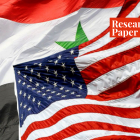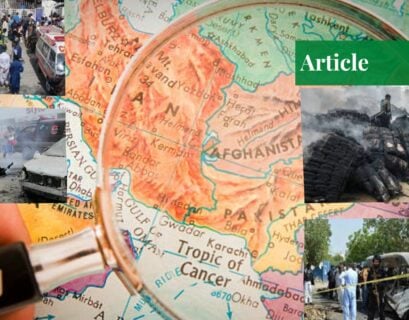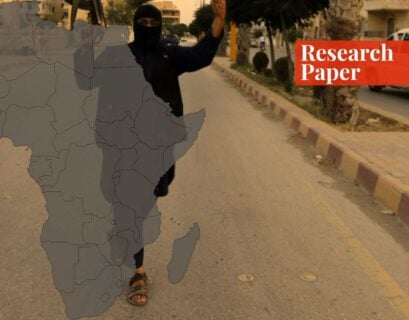Sadaf Shabbir is a student of International Relations at the University of Karachi. She is a proud bibliophile analyzing world politics and contemporary events through the lens of gender studies. She focuses on unveiling the sexism and gender biases engraved in each field and discovered writing as her way to disseminate her thoughts to the world. For her, writing serves to revamp the way people interpret certain events in society.
Domestic abuse or domestic violence is not an uncommon phenomenon, yet it is more prevalent in states like Pakistan. People frequently hear these terms in their daily life. However, what is uncommon is the term “domestic terrorism” and how infrequently one hears it. Theorists and scholars have argued that the usage of the term “domestic violence” trivializes the severity and the atmosphere of terror that the victims suffer from.
Moreover, this term has reiterated how the study of terrorism often disregards individual analysis. Hence, when defining terrorism, acts of domestic violence and abuse are often ignored Alison Jaggar, in her article “What Is Terrorism, Why is it Wrong, and Could it Ever Be Morally Permissible?”, argues that the accepted definition of terrorism will find rape and domestic violence to be terrorist acts.
Domestic Violence
Simply and comprehensively, domestic abuse and domestic violence are umbrella terms that encompass all sorts of violence, be it psychological intimidation, sexual, verbal, emotional, economic, or physical abuse, or even the threat of such controlling tactics.
The Oregon Coalition Against Domestic and Sexual Violence defines domestic violence as “a pattern of coercive behavior used by one person to control and subordinate another in an intimate relationship. These behaviors include physical, sexual, emotional, and economic abuse. Tactics of coercion, terrorism, degradation, exploitation, and violence are used to engender fear in the victim in order to enforce compliance.”
Margi Laird McCue, in her book “Domestic Violence”, defines domestic violence in quite an explicit form. She has tried to reach out to the more extensive forms of abuse that include spouse abuse, domestic assault, battering, partner abuse, marital strife, marital dispute, wife-beating, marital discord, women abuse, dysfunctional relationship, intimate fighting, and mate beating.
One notable point here is that domestic violence is rampant in developed, developing, and under-developed nation-states. It is an epidemic that is not confined by geographical boundaries and doesn’t need a visa or a passport to travel. Thus, such characteristics render it the title of a “borderless challenge”.
It doesn’t consider a person’s caste, age, and sexual orientation. Yet, gender plays a role in this abuse—often the horrific one. Though violence in a domestic setting can be against anyone; it can be against children, the elderly, or between homosexual couples.
Jay Sloan Lynch has argued, in the article “Domestic Abuse as Terrorism”, that domestic abuse against women can be seen in the historic patriarchal structure and that it is more prevalent in its perpetration against women. The number of female victims of domestic violence far outpaces any abuse against any other faction of society. However, that does not mean that men are not abused by the hands of women.
According to the global statistics given by World Health Organization, 1 in every 3 women, or 35% of the women in the world, have suffered from some sort of intimate partner or non-partner violence. The focus of the following discussion, therefore, will be on how domestic violence is in reality “domestic terrorism”, in the context of Gender-Based Violence (GBV) that ultimately targets women.
Domestic Terrorism
Although there is no unanimously accepted definition of “terrorism”, scholars have defined terrorism through different interpretations of events and the psychological behavior of the perpetrators. In the definitions of terrorism, some elements have remained the same. For instance, it has been argued, constantly, that for an act to be considered terroristic, it must have some political ingredients.
In “The Strategy of Terrorism“, David Fromkin defines terrorism as “violence used in order to create fear; but it is aimed at creating fear in order that the fear, in turn, will accomplish whatever it is, that the terrorist really desires.”
Rachel Pain has drawn a parallel analysis of domestic abuse and domestic terrorism, in the context of Fromkin’s definition. She states, “Domestic Abuse, like Global Terrorism, must be seen as a part of a desire to gain particular forms of political control. Its effects reinforce the social and political structures that produce it.” The argument that Pain has put forward can be understood by taking into consideration its two aspects—social and political.
The Psychological Impact of the Social Structure
An interconnectedness exists between the unequal social, political, and economic relations. The positioning of how a person’s relative power and authority is perceived in a society has an immense impact on his/her domestic settings. Women in this regard, are often considered the vulnerable faction of society that is in constant need of support, usually of men.
The typical patriarchal structure bestows immense control in the hands of men. It is usually the norm that women are considered the direct responsibilities of men and their honor is something that is not their own but belongs to men. Thus, this rhetoric is used to justify women being tightly controlled or chained. Since men are usually considered the “head of the house”, it is enough to make the men order and the women, obey.
That’s why, when victims and abusers are asked about their experiences, the abusers often state that whatever has been done to the women is “for their own good and protection”. Similarly, when it’s the victims’ turn to talk, they often blame themselves and reinforce what the abusers’ said by declaring, “we deserved this” or worse “we shouldn’t have done that”.
The social structure has a direct impact on the psychology of both the victims and the perpetrators. In most cases, the abusers don’t see their behavior as threatening or terroristic. Whereas, the victims are usually in some dilemma of gaslighting. The victims – women – believe that they exist to tolerate anything that comes from men and that they are responsible for upsetting the other person.
Therefore, the social structure is designed in such a way that it renders all the power in the hands of a particular masculine faction of the society. As a result, the autonomy of women is undermined in the household and the oppression of the already marginalized faction further strengthens the bulwark of the unequal social structure. This reinforces a particular stereotypical vicious cycle.
The Relation Between Socialization and Political Control
Pain has put forward another important aspect of political control that needs to be dug up. Domestic violence is usually considered something that belongs to the “private” sphere, where politics has no role to play. Usually, the terroristic actions of individuals in a domestic setting are considered family matters.
Society as a whole has failed to realize that interpersonal aggression has a much wider political context. Tomis Kapitan, in “The Terrorism of Terrorism”, emphasizes that terrorism, in fact, acts as a direct means to alter the political climate. Taking into consideration. Pain’s argument of “political control” and Kapitan’s “alteration of political climate”,
Family is considered the basic unit of socialization and the central source of society’s power structure. How someone socializes and the values that are instilled in his/her mind, decide the outcome of his/ her role in the social, political, and economic sphere at a public level. Abuse and coercion in the household can maim anyone’s potential to participate in society.
In “Justice, Gender and the Family”, Susan Okin has insisted that women’s roles and positions in the household have an unmistakable connection with their impact. This role fosters inequality, segregation, and disdain against women in the workplace, social structures, and above all, in the political dynamics.
Consider a scenario, in which a woman has been constantly terrorized and abused in the household. She is exposed to physical, psychological, and sexual violence, and intimidated by the other members of the house as well. Her basic living behavior is continuously being shaped by threats; her survival is in constant danger. Now think of millions of women around the globe facing this routinely, irrespective of geographical boundaries, class, race, ethnicity, age, or other individual characteristics.
Would they ever be able to come out of the inferiority and fear of violence? Would they ever be able to attain any job, for their sake? Forget about attaining, would they be able to even think of attaining such opportunities? This vicious cycle, knowingly or unknowingly, deliberately or inadvertently, reinforces the invisibility of women in the political sphere.
The political motivation behind domestic terrorism is to set such power arrangements in the household and terrorize women to the extent that it systematically undermines their representation in the broader political sphere. hence, the ultimate goal is to create long-lasting disadvantages for women.
The patriarchal structure has so many ways to assure the invisibility of women in any sector of the public sphere. What better way is there than to cut the wings of the bird before she knew she could actually fly? Domestic violence is thus, the private means to ensure systematic political victimization, oppression, segregation, and exclusion of women.
If terrorism is a quest for power then “domestic terrorism” is a quest for maintaining patriarchal political power via the means of oppressing and terrorizing a particular faction. This particular group, suppressed in the household, can never even think of maintaining its presence outside the domestic setting. This is how the political motivations and consequences of systematic and structural inequality, through terror, produce similar outcomes in the public sphere.

The Political Consequences of Terrorism
It is not always necessary to have political motivations all the time; domestic violence is only considered terrorism when it has a political driving force. However, we have so many incidents before us that weren’t politically motivated but were still considered a part of terrorism, due to their horrendous political consequences for the victims.
The New Zealand Christchurch shooting serves as an example of these incidents. The terrorist was a white supremacist who had antagonistic thoughts against Muslims and no direct political motivation. His act of terrorism was not prompted by any political intention or desire to influence the political body of the state.
The same can be said about the perpetrator of the Orlando nightclub shooting. The terrorist was a religious fanatic and his motivation behind the shooting wasn’t political. He wasn’t instigated by any political intentions but still, the whole international community, including the Islamic Council of New Zealand declared it a terrorist attack.
Such incidents around the globe clearly show that it isn’t just about being politically motivated or having political intentions but rather about the political consequences. Behind the conduct of any act of terrorism, the sole motivation or intention is to terrorize. Although political goals can play a role in the actions of a terrorist, they are not the primary motivation/intention of every terrorist. That slot is taken by the urge to frighten the victims and the population.
In the above-mentioned incidents, the fear generated by the terroristic events is seen as the consequence of the shootings. Even though the perpetrator was either killed or sentenced to life in prison, the victims and the general public are still terrified by the mere thought of what had occurred. The persistent psychological and physical damage prohibits those affected from functioning like they used to.
In domestic terrorism as well, the victims have always terrorized to the extent that the terror hinders their political participation. It results in the political victimization of a particular faction of the society. So the next time, you see a victim of domestic terrorism, do not just see what is being shown but rather try to think outside the box or even better, just remove the box that hinders your way of thinking critically.
An Individual’s Actions Foster the Institution of Terrorism
It doesn’t matter to what extent it has been exaggerated that intentions play a role in the recognition of a particular act as terrorism, the reality remains that the intention of an individual is not the only thing that matters. The act alone is enough to make the “institution of terrorism” go on.
For instance, consider such a scenario. What could be the possible individual intention of a rapist? Revenge? Power? Sexual lust? A rapist’s actions help in the success of the institution of rape and help it accomplish its aims. The institution works in a planned and calculated manner.
For this institution to be successful, all it needs is an individual targeting one woman and terrorizing her in such a way that her terror and suffering give a direct message to all the other women around the globe. All this institution needs is an individual’s actions, as long as they work in its favor, and not his aims to rely on.
The individual’s intentions may be just confined to the above-stated words but the aim of the institution of rape is to give the message of male dominance, tempering women’s efforts to be independent. This is the reason why the victim of sexual violence is the direct target and the primaries are all the women who can see what could happen if someone even dares to resist the structure of the society.
This is why rape and domestic violence are acts of terrorism. They not only terrorize the direct targets of such institutions but also the primary ones, with the intention to instill fear in women to the extent that they become subordinate and reluctantly accept this as their fate. Rape and domestic violence structure the whole social and political systems, by portraying themselves as something private where politics have no role to play, in such a way that these institutions have an immense impact on the public sphere.
Pakistan’s Society under Scrutiny
In Pakistan, domestic violence has become the custom, or more appropriately, it has transformed into a culture. Male dominance has been engraved to the extent that women are considered mere chattel. The patriarchal structure of Pakistan finds a way to justify any sort of domestic violence against women, sometimes even going as far as supporting honor killings.
Hence, domestic violence directed against women is considered a private matter in Pakistan, and the relation between the two sexes is taken as that of the ruler and the ruled. There are several socio-economic and cultural factors and misinterpretation or distortion of religious teachings that play a role in exacerbating this scenario.
Pakistan ranks 154 out of 189 countries on Human Development Index and the maternal mortality rate in the state hovers around 140.0%. Literacy remains a constraint for Pakistan’s patriarchal society, women’s education has always been taken into secondary terms in comparison with that of males’.
According to the HDI, only 27.6% of adult women in Pakistan have obtained secondary school level education and the participation of women in labor remains only 21.9%. In terms of the gender parity index, Pakistan remains on 3rd from the bottom, in a list of 153 states. Even the war-torn Arab Republic of Syria stands better in comparison to the Islamic Republic of Pakistan.
The dominance and interference of the clergy class in Pakistan also remain a bone of contention. The incendiary verdicts by clerics have proliferated the inferiority of women. Several members of this religious class in Pakistan teach their followers that domestic violence is in fact a religious way to keep women in check. Instilling such contaminated thought processes into the minds of the masses has resulted in the deterioration of the social fabric and jeopardized women’s existence as a human.
Someday you’d hear some bearded clerics claim that slapping or beating your wife is the religious duty necessary to control her. Then, another cleric will rise up and brag about how co-education or women’s education, in particular and in Pakistan, harms the religious culture—one that has to be saved by making women the scapegoats of domestic violence and terrorism.
Similarly, you’d also get to hear another cleric justifying the crime of marrying minors. These types of clerics have not justified domestic violence in Pakistan and supported it but have even turned the “hoor (houris)” mentioned in Islam into some sexual objects in their interpretations.
Pakistani society considers marital rape a taboo. Discussing it can cost you many raised eyebrows and some people may even label you as anti-religion just because you believe in the emancipation of women from these stagnant norms. Honor has been something that always has boggled the minds of this society; it has become Mephistopheles for women. In Pakistan, women’s honor comes with direct strings attached to fragile masculinity, and if you raise your voice over issues concerning your life, it can become a matter of life and death and lead you to suffer from domestic terrorism in the form of household violence.
Even prior to birth, women’s lives are controlled in the shape of sex-selective abortions. if they are born, the neglect they receive in their early birth years leads to a higher female infant mortality rate. Even if they miraculously survive those early years, honor killings, forced conversions, forced marriages, rapes, sexual harassment, acid attacks, eve-teasing, marital rapes, and cyber blackmailing—to name a few—await them.
Conclusion
When terror incidents like 9/11 took place, governments all around the globe declared war on terror; new laws in the legislation were not only introduced but enacted as well at lightning speed. Whereas the victims of domestic terrorism far outweigh any number of victims targeted in any terror incident, yet international governments never responded in such vigorous ways to curb this plague in society.
Each day, each corner of this planet is a witness to the terror women face each second. Every day, women are terrorized, tortured, abused, maimed, held captive, controlled, shaped, brutalized, and their basic human rights are violated. This is happening irrespective of one’s geographical boundaries. Feminist geographers point out that the toxic masculinities in one particular region contribute directly to the toxic masculinist geopolitics globally.
All the oppression in the private sphere has a direct impact on the public sphere of an individual’s life. The same goes for how such inequalities on the domestic level counter women’s participation in the global public sphere.
It is important to note that no progress can be made until women are free from these rotten shackles that have hindered their very existence. Though domestic violence and discrimination against women is a global issue, in Pakistan, some additional factors impede even the slightest effort to make a tiny contribution to alleviating this crisis.
If you want to submit your articles and/or research papers, please check the Submissions page.
The views and opinions expressed in this article/paper are the author’s own and do not necessarily reflect the editorial position of Paradigm Shift.



















